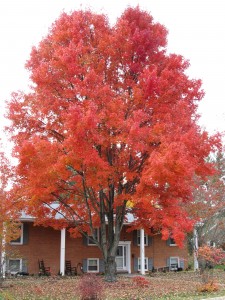Red maple (Acer rubrum) is one of the most popular large street and shade tree in the Southern Appalachian region (USDA hardiness zones 6 and 7). Most cultivars average 40-60 feet tall in height.
Tiny red flowers burst open early, often before the official first day of spring. Flowers give way to reddish double winged samaras. Its glossy dark green 3-5 lobed leaves are 3-6 inches across with deep red petioles. Many red maple cultivars strut their vibrant red foliage on a specific week in October or November.
Red maple is native to moist well drained soils, preferably in full to partial sunlight. It tolerates wet soils and is unswayed by temporary flooding such as in rain garden zones. In some Midwest states it has earned the nickname “swamp maple”.
Red maple is also cataloged as “soft maple” because high winds and ice may break brittle branches. Its notoriously shallow root system may lift up adjacent sidewalks or driveways.
Red maple may be troubled by insect or disease problems, often when the tree(s) is planted on the wrong landscape site. Leaf aphids, wood borers and scale insects can be occasional pests. Verticillium wilt disease attacks the vascular system, frequently the result of unusually long dry spells extending three or more years. It is resistant to most common urban air pollutants.
Five popular cultivars planted in the southeast and mid-Atlantic states include:
Autumn Blaze® (A. x freemanii) – 50 ft. x 40 ft. – early deep burgundy red leaf color
Red Sunset® (A. rubrum) – 45 ft. x 35 ft. – early bright red leaf color
‘Autumn Flame’ (A. rubrum) – 35 ft. x 15 ft. – better red color in southeast U.S.
‘Armstrong’ (A. rubrum) – 45 ft x 15 ft. – columnar habit for narrow street plantings
October Glory® (A. rubrum) – 40 ft. x 35 ft. – one of the latest for red color
Pruning is best performed in the spring and summer months when sap pressure in low. Sap from this tree can be used to make maple syrup during the winter months.


 Posted in
Posted in 
